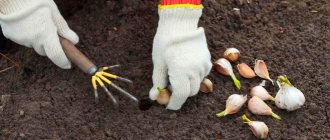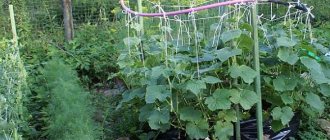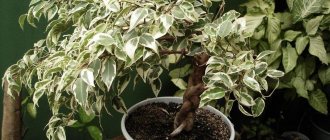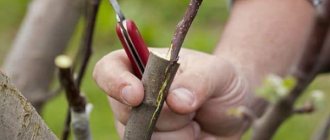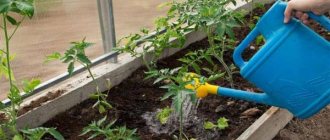The presence of a greenhouse on the estate makes it possible to create the most optimal conditions for growing crops, while using the space not only in breadth, but also in height. To do this, you need to have a site of the required size, which will be located not far from the house, since light, heat and water supply are usually organized precisely from it. What other nuances need to be taken into account in order to correctly position the greenhouse on the site?
Proper location provides greenhouses with maximum light
How to orient a greenhouse to the cardinal points
If a greenhouse is installed in the local area, the owner naturally expects high yields of the crops grown in it. This can only be achieved by the correct illumination, which will be ensured by the most optimal orientation in space.
The point is simple: the more sun that gets inside, the less money you have to spend on additional heating and lighting, without which the process of photosynthesis slows down. And in general, no source of artificial light can replace the sun one hundred percent - without it, productivity will inevitably decline.
Only the sun will ensure good yields
North-south or east-west?
First of all, the location of the greenhouse is oriented on the site according to the cardinal directions. It can be latitudinal, when both the building frame and the beds have a west-east orientation. In this case, the sun enters the greenhouse throughout the daylight hours, not on one side, but on the other. True, the midday heat will be tiring for plants, especially in southern latitudes.
- When the direction is given north-south, this orientation is called meridional. Plants on the north side do not receive enough light, become overly elongated and do not bear fruit as actively. But in this case, there will not be so many of them at the end of the greenhouse, because the long sides of the frame will be illuminated from the east and west.
- Most plants will be quite comfortable in this situation (it is shown in the picture below): there is enough light, and the sun is not too hot at noon.
The optimal location of the greenhouse for southern latitudes is meridional
- For complete photosynthesis in plants, it is always better when the greatest amount of light enters the greenhouse in the first half of the day. And this is only possible when the greenhouse is oriented to the east or southeast.
- But the configuration of the site and its existing development do not always allow choosing the location of the greenhouse on the site that is required for maximum plant comfort. If the orientation from west to east does not work, you can simply shift the timing of growing seedlings.
- For example, with a meridian location of the building, it is very convenient to grow cucumber seedlings in the spring in order to harvest in the fall. In this case, it will not be possible to have vegetables on the table by February-March.
Note: it is not advisable to orient greenhouses from north to south in northern regions. In the summer there is enough light there, because the nights are white, but the rest of the time the plants will be sorely lacking it.
Read on our website: winter greenhouses for summer cottages.
Place for a polycarbonate greenhouse
When choosing a location for a polycarbonate greenhouse, it is also important to consider the sufficiency of lighting. The lack of this characteristic will lead to additional costs. First of all, it is necessary to use the south-eastern and southern sides, as they will provide the plants with the level of natural light necessary for their growth.
For a greenhouse, it is possible to use the immediate vicinity of short trees as protection from the heat. The presence of such a neighbor will save the plant’s leaves from burns.
It is not recommended to install the structure on a slope. Slope is not allowed. This defect can be eliminated by building a foundation. At the same time, a slightly sloping area to the south is favorable for greenhouses, but to the north it is not worth considering as a place for a greenhouse.
It's bad if you place:
- Near fences;
- On a slope;
- Near a large and tall neighboring building.
This is due to the fact that fences and buildings will constantly shade the plants in the greenhouse. The level of illumination in the greenhouse and the opportunity to save on energy costs depend on the correctly chosen location of the greenhouse. It is good to install a polycarbonate greenhouse on a hill. This will prevent flooding of the main structure and seedlings during precipitation and melting snow. If there is no other option and the structure needs to be built in a lowland, then you need to put an auxiliary layer of soil on the bed.
How to place two greenhouses on a site
If you decide to install not one, but two greenhouses at once, it means that the size of your plot allows this. All that remains is to decide on their relative position. The ideal option is to place the frames side by side, with a step of 80-100 cm. At a minimum, this will make it possible to walk between the greenhouses and remove debris or snow.
If the length of the site allows, the greenhouses can be joined at the ends in one line or perpendicularly, which will save space and simplify the laying of communications.
Options for placing two or more greenhouses:
PENTAX Image
Greenhouse on the roof
The lack of building space forces people to get creative when figuring out where to place a greenhouse. The option with a used roof is not the worst. It is advisable to include it in the design, although some manage to redo the existing roof.
Greenhouse on the roof
This option can only be implemented on a reinforced concrete floor (read the article on how to make floors in a house), taking into account the weight of the soil and ensuring the proper level of waterproofing. Although, in our opinion, remodeling the roof is not economically feasible. After all, this is how much vegetables need to be grown in a greenhouse for these costs to be recouped! It’s another matter when you are building a new house with a glazed roof, and instead of a winter garden you want to organize a greenhouse there.
House with a winter garden on the roof
Take a fresh look at the area
The installation of a greenhouse will depend on the type and location of the plot you receive. If you are planning to develop a completely new and free plot of land, you have some room to turn around. And you have many options for the location of the greenhouse. It’s worse if the area is already partially sown and planted with trees - in this case, the “room for maneuver” is significantly reduced.
Before installing the greenhouse, the site should be cleared of debris and all holes should be filled.
There are at least four important factors that you definitely need to pay attention to so that the planning and construction of the greenhouse goes smoothly.
- Characteristics of a dacha landscape . These include the presence of slopes, elevation differences, groundwater levels, the presence of reservoirs, the depth of soil freezing, etc.
- Location relative to the cardinal directions and the movement of the sun, as well as the general illumination of the area. Plants in a greenhouse should receive maximum light per day - the speed of their growth and maturation directly depends on this. Therefore, greenhouses cannot be placed in the shade of trees, houses or other buildings.
- The composition and quality of the soil in the proposed location of the greenhouse.
- Convenience of placement.
Sometimes all the factors are not in favor of installing a greenhouse (the site is on a slope, groundwater is close, the soil is heavy and poor, there is an abundance of shade on the site). In this case, it is better to abandon the construction of a greenhouse altogether, since it will be impossible to achieve good harvests. If all components of the site are more or less favorable for the placement of the greenhouse, you can proceed to detailed planning.
Summing up
The article examined options for placing greenhouses on the site from the point of view of the convenience of its owner and the comfort of the plants. But what about the distance to the neighbor’s fence - what should it be? According to the standards prescribed in SNiP, no matter how many acres you have, the distance between outbuildings and the fence is at least 1 m. But in general, it is better to increase this distance, since snow will inevitably accumulate in this passage in winter.
What to avoid when placing a greenhouse
Where can I find video instructions for the location of the greenhouse?
The procedure for determining the location of the greenhouse, taking into account the cardinal directions, is clearly demonstrated in the following video. Thus, careful selection of the location for the greenhouse and determination of its direction are of great importance in growing garden crops on closed ground. After all, a greenhouse that receives a sufficient amount of heat and light, and also does not risk being flooded by shallow groundwater, allows the farmer to receive a much more abundant and high-quality harvest than a greenhouse located in the wrong way.
No. 4. Does a greenhouse need a foundation?
Experienced summer residents prefer to equip the foundation for a future greenhouse. It helps solve a lot of problems:
- maintaining heat and protecting plants from frost;
- protection of the soil and greenhouse from rain streams;
- ensuring reliable fastening of the frame;
- protecting the frame material from destruction.
And if in some cases you can still do without a foundation, then you will definitely have to equip it if:
- the greenhouse is used all year round;
- the frame is made of wood;
- the structure is buried in the soil below its freezing level;
- the greenhouse is large (more than 6 m in length);
- the structure is located on a slope or in a poorly protected place.
Installation Features
If a place is found where the owner will install the greenhouse with his own hands, then at the first stage the site should be prepared for the construction of a greenhouse structure. The area must be completely cleared of any debris, and its area should be slightly larger than the area of the greenhouse structure itself.
There are several universal recommendations on how to install such a structure. Strict adherence to them will allow you to carry out the installation yourself as easily and quickly as possible.
First, the frame base is assembled, which can be installed directly into the ground or onto the foundation. A treated wooden beam is used as the bottom frame or a shallow monolithic base is erected.
The type of foundation depends on the category of the greenhouse, its size, and the material used for covering. The timber can be used to fasten lightweight greenhouse frames coated with polycarbonate. In addition, it should be remembered that the timber used must be of the highest quality; it should be treated with special compounds against rotting. It is not practical to install glazed greenhouses on a wooden foundation. For heavy greenhouses made of glass or window frames, you should make a poured or brick foundation, which you can quickly build with your own hands.
To make it as easy as possible to build a frame with your own hands, each factory product comes with instructions for assembling the greenhouse
You may also be interested in an article about choosing the type and options for making a foundation for a greenhouse.
No. 3. Greenhouse frame material
The resistance of the greenhouse to all negative environmental factors depends on the frame: winds, the weight of snow, mechanical damage, etc. It is better to spend money once on a more reliable and durable structure than to repair or change it every year. Today, manufacturers offer frames made of wood, plastic and metal . Let's figure out which one is better.
Wooden frame
Wood is the most affordable material for constructing a greenhouse frame, so its popularity in domestic spaces is consistently high, despite its imperfections. Many craftsmen who decide to build a greenhouse with their own hands choose wood, since it is easy to process and has a low weight . include :
- high environmental friendliness;
- corrosion resistance;
- good thermal insulation qualities;
- low cost.
Main disadvantages:
- low strength, in this parameter wood is inferior to plastic and metal;
- ability to absorb moisture and rot;
- the need for constant care to protect against the influence of moisture, mold and pests;
- low durability and the need for constant repairs.
If you do not think through a system for removing water from the greenhouse, the wooden frame will not last long. Such designs remain popular only due to their low cost.
Plastic frame
A PVC frame is one of the most suitable options for greenhouses, but so far it is not often used in our country due to its high cost , which is explained by the complexity of processing the material.
Advantages:
- high aesthetics;
- strength;
- resistance to alkalis, acids, fertilizers and other chemicals;
- resistance to corrosion and rotting;
- low weight and easy DIY installation;
- low thermal conductivity.
Aluminum frame
Aluminum frames are assembled from pipes or profiles, their characteristics are almost identical, and the main advantages are as follows:
- ease;
- rust resistance;
- minimal maintenance and ease of installation.
Minuses:
- high price;
- low thermal insulation.
Steel frame
A steel frame is the best choice today in terms of price and quality ratio. Main advantages : strength, durability, ability to withstand heavy loads, and all this at a fairly low price. The main disadvantages are low thermal insulation properties and susceptibility to corrosion.
The steel frame can be made from:
- pipes;
- profile.
The difference is significant, each material has its own advantages, and the debate over which option is better is reminiscent of arguments about what came first, the chicken or the egg.
The steel pipe frame is the ideal of strength and durability. It is not afraid of snow and wind loads, it will not bend or deform in winter, but you will have to pay for all this: a pipe frame costs much more than a similar one made from a profile. Moreover, it is worth taking into account the large weight of the structure and difficulties in transportation and sometimes installation.
A profile frame is cheaper, easier to install, and it’s not a problem to install it yourself, but it is inferior in strength to its pipe counterpart, so it may require reinforcement.
Steel is susceptible to corrosion, and for protection the frame is galvanized or painted . The second option is cheaper, but requires periodic touch-up to avoid corrosion on the metal and rust spots on the covering material. A galvanized frame will cost a little more, but it is considered a more preferable option, since it will not need additional protection for at least the next 10 years.
To ensure that the metal frame lasts more than one season, pay attention to the following parameters:
- The fewer elements were used to produce the arches and pediments, the better. The ideal is solid-bent arches and welded gables ;
- profile cross-section – 20*40 mm, it is impossible to find more;
- metal thickness – at least 1.2 mm;
- the distance between the arches is at least 0.67 m , otherwise, at the first light snow, the covering material together with the frame will bend.
No. 5. Which foundation for a greenhouse is better?
Depending on the objectives pursued, choose one of the following foundation options:
- tape , which is organized using concrete, less often sleepers, brick or gravel. Previously, the arrangement of such a foundation was considered mandatory, but is still carried out by many summer residents. The construction is almost permanent; it will be impossible to move it to another place;
- the block foundation is made of reinforced concrete blocks, it is suitable for regions with loose soil;
- pile and point foundations are easy to install and allow you to build a strong, reliable greenhouse;
- timber foundations have recently been used more and more often; they can be equipped even by not the greatest professional in the construction industry. The tree will require pre-treatment with antiseptics, but a greenhouse with such a foundation can be easily moved from one place to another - ideal for growing vegetables.
No. 6. Types of greenhouse coverings
It is easy to notice that the largest area of the greenhouse is occupied by the covering material, so summer residents pay maximum attention to its choice. Currently the following materials are actively used:
- regular and reinforced polyethylene film;
- glass;
- polycarbonate
Each of these materials copes with its direct functions differently.
Glass cover
Previously, glass was almost the only suitable material for arranging a greenhouse. Today everything has changed, but it continues to be used due to the following advantages :
- good light transmittance;
- high thermal insulation characteristics;
- resistance to temperature changes and chemicals;
- durability;
- aesthetics.
Minuses:
- heavy weight, requiring a very good frame;
- fragility. Hail can damage the material, and using laminated or tempered glass is too expensive;
- long and labor-intensive installation process;
- lack of a filter against infrared radiation, which can be harmful to some plants.
Glass is chosen with a thickness of at least 4 mm . The larger the sheets, the higher the light transmission (the area of the frame decreases), but the higher their fragility.
Polyethylene coating
It’s worth taking a look at any dacha cooperative to notice that plastic film is most often used to equip greenhouses.
Advantages:
- good light transmission and the ability to softly diffuse light;
- low price;
- ease of use and low weight;
- protection of plants from light frosts (down to -30C);
- Suitable for greenhouses of any shape.
Flaws:
- rapid wear, especially at fastening points, so the film will have to be changed every year;
- accumulation of condensation film on the surface, which can lead to a number of diseases in plants.
For the low price and ease of use, summer residents forgive polyethylene for its fragility.
If you look at it, the material is presented on the market in several varieties:
- ordinary polyethylene film . Sold in rolls 120-300 cm wide, it requires special care when installing on a frame, since the slightest cut can soon increase significantly. It is better to seal especially dangerous places with tape to guarantee;
- PVC film is more expensive than polyethylene film, but is much stronger, can last 5-7 years, retains heat accumulated during the day well, and blocks infrared rays;
- reinforced polyethylene film can serve for several seasons in a row, as it is equipped with an internal frame made of fiberglass, polypropylene, twisted polyethylene or other materials. Can withstand hail and strong winds.
Polycarbonate cover
The most modern and price- and quality-balanced material for covering greenhouses is cellular polycarbonate. Please note that there is also monolithic polycarbonate on the market, but it is not suitable for greenhouses. Cellular polycarbonate has a special structure: inside it there are partitions (honeycombs) filled with air. This structure provides many advantages:
- high strength, 200 times higher than that of glass. Rain, strong wind and even hail will not harm polycarbonate;
- excellent light transmission and much better heat retention abilities than glass;
- ease of work, since the material bends well, is easy to cut and drill, and is light in weight;
- relative durability (up to 15 years);
- great appearance.
When choosing polycarbonate for a greenhouse, you should pay attention to the thickness : it should be at least 4 mm , and preferably 6 mm; for arranging the roof of a greenhouse, it is better to look for sheets 7-8 mm thick. Without special protection, the material does not withstand sunlight well, so there must be a protective layer - do not believe sellers who talk about using protective additives in bulk, this is all short-lived material. When heated, polycarbonate tends to expand, so experienced specialists recommend installation at a temperature of at least +100C and fastening the sheets overlapping.
Other materials for covering greenhouses
The following materials can also be used to cover the greenhouse:
- spunbond is a non-woven material obtained from a polymer melt with the addition of stabilizers for resistance to ultraviolet rays. This is a dense white fabric, often called agrofibre. It has good strength, light transmission, high thermal insulation properties, is resistant to rotting, temperature changes and chemicals, and will last up to 5 seasons;
- plexiglass is a durable material, suitable for northern snowy regions. The downside is the high price;
- Fiberglass is made from polyester resins, reinforced with reinforcement, and retains heat well.
No. 7. Greenhouse shape
To ensure a good harvest, it is not enough to choose a suitable frame and covering material; you also need to find the optimal shape. The most common options:
- arched greenhouses , as well as domed and teardrop-shaped ones, retain heat well, are easy to arrange, do not contain sharp corners, therefore they require much less covering material, and precipitation does not linger on them. Such structures can be transformed, but they are limited in the choice of coating - mainly polycarbonate is used. In addition, access to the outer beds will be difficult;
- greenhouses with a gable roof will require more material for arrangement, but the area for planting in them is significantly larger. The design provides excellent lighting even under cloudy skies, withstands snow loads well, but is more expensive than the arched one;
- lean-to greenhouses are often installed near the wall of the house, which allows for significant savings. It is better to direct the roof slope to the south side;
- A pyramid greenhouse is an option for those who love everything unusual. The designs are complex in execution and are in demand among gardeners;
- a polygonal greenhouse is an impressive and expensive structure, but due to the presence of a large number of sides, the structure warms up well at any time of the day.
